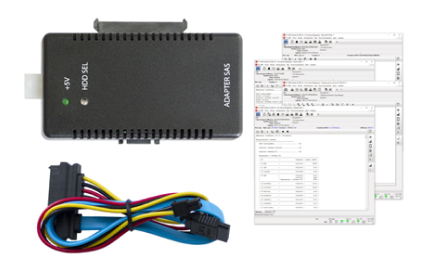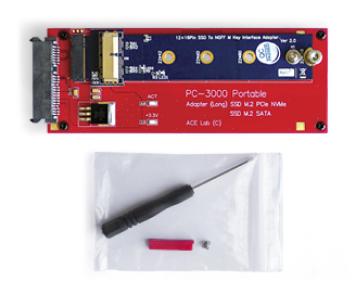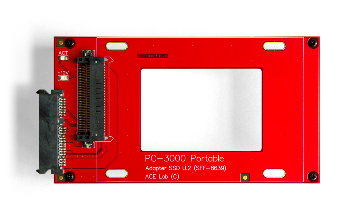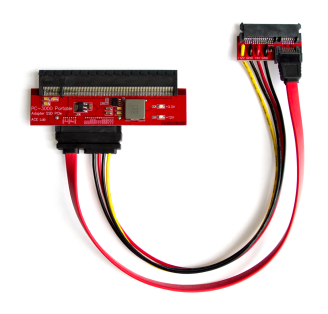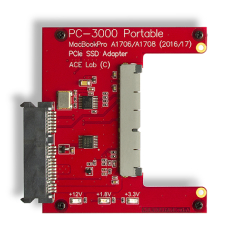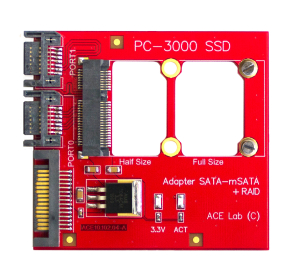Portable PRO
4 diagnostic ports to recover data
Use 3 universal PCIe/SATA ports and 1 USB HOST port at the same time
More powerful 120W PSU is inside the delivery kit!


Breakthrough: now you can work with 3 pcie nvme at once!
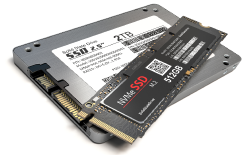
Superb
for both on-site
and in-lab
data recovery

Make your own
workstation
out of one device
PC-3000 portable pro operating modes
Full-Featured Mode
of different complexity
as ever possible
Standalone mode for onsite recovery

Hash-sum calculations
when copying and reading data

Drive settings SMART view
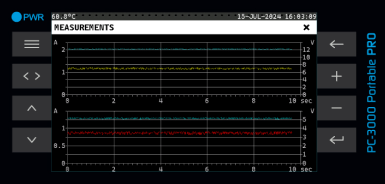
Oscilloscope function
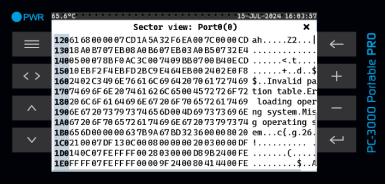
Sector view
What’s new in pro version?
| Comparative characteristics | PC-3000 Portable III | PC-3000 Portable PRO |
|---|---|---|
| ROM | 4 MB | 16 MB |
| RAM | 1 GB | 2 GB |
| Displayed diagonal screen area | 72 mm | 100 mm |
| Touch screen | no | yes |
| Graphical user interface | no | yes |
| Oscilloscope function | no | yes |
| Power Supply Unit | 90W | 120W |
| Main communication interface with the control computer | USB 3.0 | USB 3.1 |
| Number of simultaneously operating ports | 3 | 4 |
| Number of simultaneously operating NVMe/PCIe drives | 1 | 3 |
| Diagnostic Port 0 | PCIe/SATA 5V-3А, 12V-2,5А |
PCIe/SATA 5V-3А, 12V-2,5А |
| Diagnostic Port 1 | SATA 5V-2А, 12V-2,5А |
PCIe/SATA 5V-3А, 12V-2,5А |
| Diagnostic Port 2 | SATA 5V-2А, 12V-2,5А |
PCIe/SATA 5V-3А, 12V-2,5А |
| Diagnostic Port USB (HOST) | USB 3.0, 5V-2А | USB 3.1, 5V-3А |
| Support of Intel Optane SSD interface | no | yes |
| Improved anti-interference ability of PCB | no | yes |
| Ability to turn off and turn on the device from the touch screen button | no | yes |
Interface type: USB 3.1
Diagnostic ports: USB 3.1 (Host), Port 0 (PCIe / SATA), Port 1 (PCIe / SATA), Port 2 (PCIe / SATA)
Power adapter: 4-channel independent power adapter with protection from overvoltage and current overloading, with current and voltage measurements
Operating temperature range: 0-40°C thanks to the Climate Control System
Power Supply: 120W External AC / DC 19 V
Number of active licenses: 2 (to install the software on both a desktop computer and a laptop)
Other: Touch screen, non-volatile Memory to keep log files with date, time (GMT), username and settings which can be used in the reports later on.
The built-in lithium power supply ensures uninterrupted operation of the century-old calendar and world clock (UTC).

Recommended system requirements:
CPU: Intel Core i5 (4 cores, 4 threats) or AMD Ryzen 5;RAM: 16 GB;
Available disk space: 1TB HDD/SSD (for installation of software and HDD/SSD resources);
Operating system: Windows 10, 11*, x86, x64;
Display: Widescreen Full HD 1920x1080 display.
Ports: USB 3.1 Type-A port for connection of PC-3000 Portable PRO (an Intel xHCI HOST controller is recommended);
USB 3.1 Type-A or USB 2.0 port for PC-USB-TERMINAL connection.
* with switched off Secure Boot State in BIOS/UEFI and disabled Windows Core Isolation

Supported devices and file systems:
| SATA / PATA HDD (3.5", 2.5",1.8") |
Supported interfaces: |
SATA (Serial ATA) and USB devices compliant with the Mass Storage Device specification, i.e. external USB 2.0/3.0 HDD. SSHD (Solid State Hybrid Drive). PATA (PATA HDDs at least 250 GB) - via a special PC SATA-PATA adapter from ACE Lab which can be bought optionally. |
| Supported vendors: | Seagate, Western Digital, TOSHIBA, HITACHI / IBM (HGST), Samsung, Maxtor | |
| Supported capacities: | From 40 GB and more (without upper limit) | |
| SAS HDD / SSD (3.5", 2.5")* |
Supported interfaces: | SAS (Serial Attached SCSI) |
| Supported vendors: | Seagate, Western Digital, HITACHI / IBM (HGST), Fujitsu | |
| Supported capacities: | From 80 GB and more | |
| SSD** | Supported interfaces: |
SATA II/III Micro SATA, PATA, LIF, ZIF, Apple proprietary interface mSATA - via a special SATA-mSATA RAID adapter from ACE Lab which can be bought optionally M.2 SATA - via a special universal M.2 PCIe NVMe/AHCI SSD & M.2 SATA SSD adapter included in the delivery kit M.2 PCIe NVMe and M.2 (NGFF) - via a special universal M.2 PCIe NVMe/AHCI SSD & M.2 SATA SSD adapter included in the delivery kit The Apple MacBook SSD M.2 NGFF PCI-e NVMe Macbook SSD 2013-2019 (12+16 pin) - via the PCIe NVMe/AHCI Adapter for Apple Macbook SSD from ACE Lab which can be bought optionally PCIe NVMe x4 SSD installed into MacBookPro 13 laptops manufactured in 2016-2017 via a special MacBookPro A1706/A1708 adapter from ACE Lab which can be bought optionally PCIe x1-x16 - via the PCIe x16 SSD Adapter from ACE Lab which can be bought optionally CFexpress - via a special CFexpress Adapter from ACE Lab which can be bought optionally U.2/U.3 (SFF-8639) - via a special SSD PCIe U.2 Adapter from ACE Lab which can be bought optionally Intel Optane H10/H20 - via a special SSD PCIe NVMe/AHCI + Intel Optane Adapter from ACE Lab which can be bought optionally |
| Supported vendors: | A-DATA, AMD, Apacer, Corsair, Crucial, DEXP, Foxline, G.Skill, Gigabyte, GoodRam, HP, Intel, KingDian, Kingspec, Kingston, Kioxia, Lenovo, Lexar, Lite-On, Micron, OCZ, Patriot, Plextor, PNY, QUMO, RevuAhn, RunCore, Samsung, SanDisk, Seagate, Silicon Power, Smartbuy, TeamGroup, Toshiba, Transcend, WesternDigital etc. More manufacturers are added with the updates | |
| Supported capacities: | From 32 GB and more (without upper limit) | |
| USB Flash*** | Supported interfaces: |
USB devices that comply with the Mass Storage Device specification, i.e., external USB 2.0 / 3.0 Flash. SD/MicroSD Memory Cards via the special 2-in-1 Card Reader Adapter included in the delivery kit |
| Supported vendors: | A-DATA, Apacer, Corsair, Goodram, Kingston, Lexar, Samsung, Sandisk, Silicon Power, Smartbuy, Toshiba, Transcend, Verbatim and others | |
| Supported capacities: |
From 256 MB and more (without upper limit) Up to 1 TB for SD/MicroSD Memory Cards |
|
| RAID**** | Supported virtual RAID levels: |
|
| Files Systems | FAT, exFAT, NTFS, ReFS, HFS+, APFS, EXT2/3/4, XFS, F2FS, ReiserFS, BtrFS, VMFS, UFS1/2, ZFS, DHF4.1, WFS0.x (for video recorders) and virtual machine images | |
* for dealing with SAS HDD/SSD using your PC-3000 Portable PRO, you need to get the SAS adapter with Special Utilities additionally
** to work with Solid-State drives you need the PC-3000 solution which supports SSD: PC-3000 Portable SSD, Ultimate System or All-In-One System
*** the PC-3000 Portable PRO is able to recover data only from logically damaged (partition corruption, deleted files, damaged File System, etc.) Flash drives. To recover data from physically damaged Flash, you need PC-3000 Flash
**** to work with RAID you need the PC-3000 solution which supports RAID arrays: PC-3000 Portable RAID, Ultimate System or All-In-One System
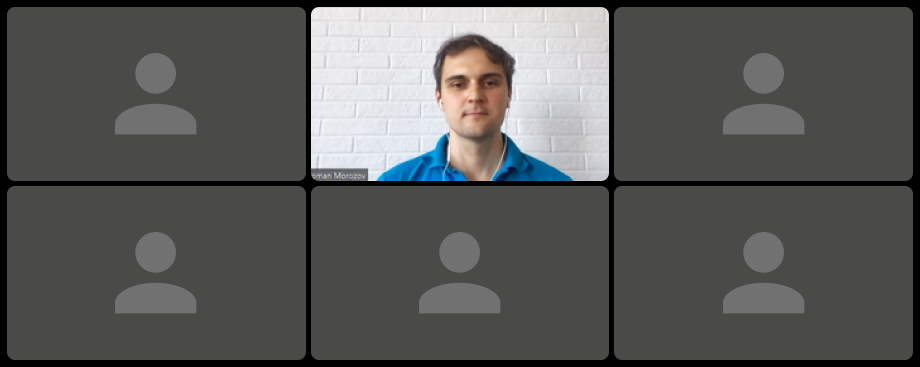
| August 19, 2024 | The New Software Update: PC-3000 Ver. 7.5.x, Data Extractor Ver. 6.5.x, PC-3000 SSD Ver. 3.5.x has been released |
The new PC-3000 Express/UDMA/SAS/Portable software version 7.5.x has been released.
The latest update brings a lot of new useful features, like full support of 4K displays into the PC-3000 interface, new families for WD Marvell and Seagate F3, the new HDD ROM wizard for Seagate drives as well as the new implementation of T2 translator recovery with WDC Marvell utilities and the new Silicon Motion controllers. Check out the full article and watch our new overview video! |
|
| Read more... |
|
| February 09, 2024 | Supermassive Software Update: PC-3000 Ver. 7.4.x, Data Extractor Ver. 6.4.x, PC-3000 SSD Ver. 3.4.x |
It’s one of the biggest PC-3000 updates ever, and it brings so many changes and improvements. See the list of the main enhancements in the full article ACE Lab technical engineers have made a short overview video of the new features available in the latest update. We highly recommend you to watch it from beginning to end for better understanding how the new modes and features work. |
|
| Read more... |
|
| June 8, 2023 | New PC-3000 Ver. 7.3.6, Data Extractor Ver. 6.3.6 / PC-3000 SSD Ver. 3.3.3 has been released |
|
The latest PC-3000 Software is available! All this is available in the freshly-released versions of the English, Chinese, Japanese, and Korean software:
All authorized technical support users will get the latest software version. |
|
| Read more... |
|
| December 8, 2022 | The new PC-3000 Software Ver. 7.2.12, Data Extractor / Data Extractor RAID Edition Ver. 6.2.11, PC-3000 SSD Ver. 3.2.9 has been released |
|
The latest PC-3000 Software is available! Thanks to the new SDK we have recently switched to, it's already been the 3rd major software update released this year. The new update has brought the enhanced T2 Reading and Analysis Mode, the support of PS5012, PS3112, and of new SAS SSDs, as well as many more other useful features to improve your work with data recovery cases! All this is available in the freshly-released versions of the English, Chinese, Japanese, and Korean software:
All authorized technical support users will get the latest software versions. |
|
| Read more... |
|
| June 2, 2022 | A new software version of the PC-3000 Ver. 7.1.6, Data Extractor / Data Extractor RAID Edition Ver. 6.1.6, PC-3000 SSD Ver. 3.0.4 has been released |
|
Great news for the data recovery community: with the new PC-3000 Software Update, you can unlock the Techno Mode for WD SED drives of all SMR 2.5" and 3.5” families without any custom PCB. It’s the easiest and most convenient way how to do this! This release has also brought the support of LVM2 thin pools and PS5016 PCIe 4.0 NVME drives as well as loaders for PS3111 and SM2259XT controllers. These features and many more are already available in the latest version of the English, Chinese, Japanese, and Korean software:
All authorized technical support users will get the latest software versions. |
|
|
Read
more... |
|
| February 16, 2022 | The New PC-3000 Software Version is Available! |
|
At the ACE Lab Webinar on the Modern Challenges in Data Recovery & Digital Forensics, our technical engineers showed the features available with the PC-3000 Version 7.0.x., for example, TLER (time-limited error recovery) for WD HDD, the Data Extractor error-processing scenario, and the support of new NVMe drives based on Marvell 88SS1093 controller. These features and more are now available in the latest version of the PC-3000 Software:
|
|
|
Read
more... |
|
| May 26, 2021 | A new software version of the PC-3000 Ver. 6.9.9, Data Extractor / Data Extractor RAID Edition Ver. 5.12.5, PC-3000 SSD Ver. 2.10.2 has been released |
|
Since now, it's possible to work with Phison PS3111-based drives, which have YMTC NAND memory on board. The new update brings an opportunity to decrypt the external USB drive Transcend ESD230C with SM2258XT controller, and also it brings extended loaders support for SM2259XT drives, improvements in software stability and speed. Hurry up to download the latest version of the English, Chinese, Japanese and Korean software:
All authorized technical support users will get the latest software versions. |
|
|
Read
more... |
|
| April 30, 2021 | The Most Recent Software Versions of the PC-3000 Portable/Express/UDMA/SAS, Data Extractor/Data Extractor RAID Edition, PC-3000 SSD/PC-3000 SSD Extended are Released! |
|
The ACE Lab Online TechCon on Data Recovery & Digital Forensics 2021 revealed a huge number of the most up-to-date features for your PC-3000 tools: support of the new drives families and controllers, T2 Recovery visual mode for SMR drives, a new class of additional maps, and many others functions that make your data recovery job easier and faster. Hurry up to download the latest version of the English, Chinese, Japanese and Korean software:
All authorized technical support users will get the latest software versions. |
|
|
Read
more... |
|
| December 10, 2020 | The new versions of PC-3000 Portable/Express/UDMA Ver. 6.8.8, Data Extractor / Data Extractor RAID Edition Ver. 5.11.5, PC-3000 SSD / PC-3000 SSD Extended Ver. 2.9.5 are available! |
|
We continually enhance the PC-3000 tools by adding new modes, algorithms, and functions. Today we are glad to announce that the following English, Japanese, Korean, and Chinese software updates are released:
All authorized technical support users will get the latest software versions. |
|
|
Read
more... |
|
| October 16, 2020 | The PC-3000 Portable III Now Supports the Silicon Motion SM2258XT SSDs! |
|
ACE lab developers have done a great job by researching Silicon Motion SM2258XT SSDs and optimizing the algorithms to make the most efficient and stable Utility for this type of the drives. As such, you can now raise your data recovery success rate by dealing with Silicon Power Slim S55, KingDian S200, WD Green, Apacer AS350 Panther, Patriot P200, Smartbuy Jolt, RevuAhn 885, Crucial BX500, and other SM2258XT SSDs. The support appears with the beta version of the PC-3000 SSD Extended software ver. 2.9.3 available for the PC-3000 Portable III users. To get the beta version of the software, please contact our Technical Support Department. |
|
|
Read
more... |
|
| September 30, 2020 | The New Software Add-On: PC-3000 SSD Extended! |
|
The ACE Lab developers constantly research drives which results in a rapid expansion of the support list for the most modern storage media devices. Today, we have released PC-3000 SSD Extended – the new software add-on that supports the widest range of SSD types: SATA, mSATA, M.2 SATA, M.2 PCIe NVMe/АHCI, PCIe x16, Apple Macbook, LIF, ZIF, PATA. The additional features of the PC-3000 SSD Extended add-on for PCIe SSD (NVMe/AHCI) appear with the beta version of software available for the PC-3000 Portable III users only. To get the beta version of the software, please contact our Technical Support Department. |
|
|
Read
more... |
|
| April 30, 2020 | The new versions of PC-3000 Express/UDMA-E/Portable Ver. 6.7.12, Data Extractor Ver. 5.10.7, Data Extractor RAID Edition Ver. 5.10.7, PC-3000 SSD Ver. 2.8.2 are available! |
|
Last week, you saw a lot of new PC-3000 functions at the ACE Lab Online Technology Conference on Data Recovery & Digital Forensics 2020. Today all these features are waiting for you in your update boxes! The following English, Chinese, Japanese and Korean software updates are released:
All authorized technical support users will get the latest software versions. More details are available in the link below. |
|
|
Read
more... |
|
| April 14, 2020 | The PC-3000 Portable III Now Supports the NVMe SSDs Based on Phison PS5007 Controller! |
|
The PC-3000 Portable III is the first and the only solution for recovering data from PCIe NVMe SSDs using the Techno Mode. At the initial release, it supported only Silicon Motion SSDs based on SM2260 and SM2263 controllers. But it was just the beginning! Now we have significantly expanded the list of supported drives by adding the NVMe SSDs based on the Phison PS5007 controller. And since all the PS5007-based SSDs are technically the same, you can recover data from any model based on this controller, even if it’s not listed in the Utility. More details are available in the link below. |
|
|
Read
more... |
|
| March 23, 2020 | The PC-3000 Portable III Is Even Faster and More Powerful Now! |
|
ACE Lab developers continue enhancing the software of the PC-3000 Portable III System with new features for the user community. As a result, the most universal and powerful tool became even faster – now the speed of internal copying is up to 490 MB/s. We also added the support of HDDs and SSDs with a logical sector size other than 512 bytes that had not previously been possible. Besides, it’s no longer required to disable the Secure Boot option in UEFI (BIOS) before the PC-3000 Portable III installation. More details are available in the link below. |
|
|
Read
more... |
|
| March 10, 2020 | The PC-3000 Portable III: New Features and Supported Devices |
|
The well-designed and flexible architecture of the PC-3000 Portable III allows the ACE Lab developers to continue enhancing this incredibly powerful product on the software and internal firmware levels. As such, you get a hardware-software tool that is constantly evolving by obtaining a lot of new features and supporting new models of storage media devices, along with new standards and interfaces. There are so many features that have been added to the PC-3000 Portable III just within one month! Take a glance at them by clicking the link below. |
|
|
Read
more... |
|
| January 20, 2020 | The new version of the PC-3000 software ver. 6.7.x and Data Extractor/Data Extractor RAID Edition ver.5.10.x for the PC-3000 Portable III Systems |
|
The PC-3000 Portable III Systems come with a new version of the PC-3000 software ver. 6.7.x and Data Extractor/Data Extractor RAID Edition ver.5.10.x. More details are below: WD Marvell
Seagate F3
Seagate ST10
HITACHI-IBM-ARM
Samsung HDD
Toshiba
The PC-3000 Core
RAW recovery
Silicon Motion
Phison
|
|
|
Read
more... |
|
M.2 PCIe NVMe/AHCI SSD & M.2 SATA SSD adapter

SAS adapter with special software utilities

PC-SATA-PATA adapter set

SSD PCIe NVMe/AHCI + Intel Optane Adapter

SSD PCIe U.2 Adapter

PCI-E x16 SSD Adapter
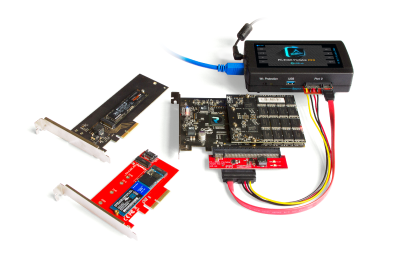
PCIe NVMe/AHCI Adapter for Apple Macbook SSD
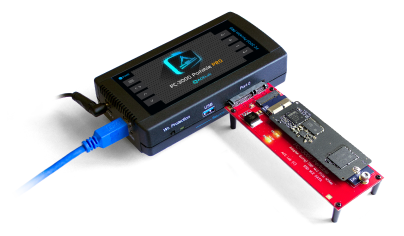
MacBookPro A1706/A1708 adapter

SATA-mSATA RAID adapter
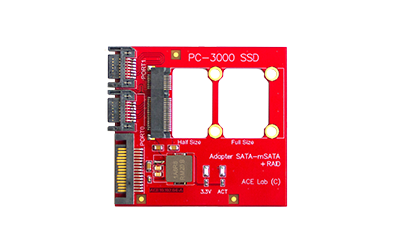
2-in-1 SD/microSD Card Reader adapter
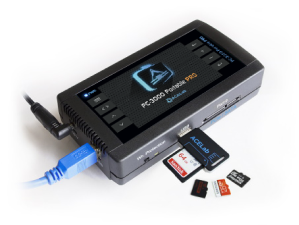
SATA Port Protector adapter
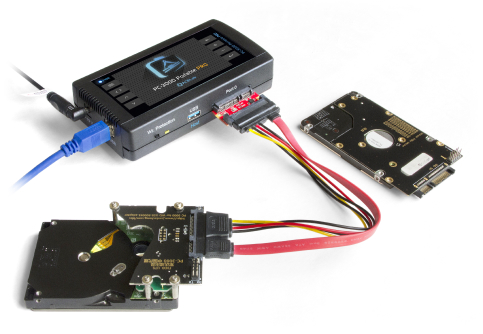
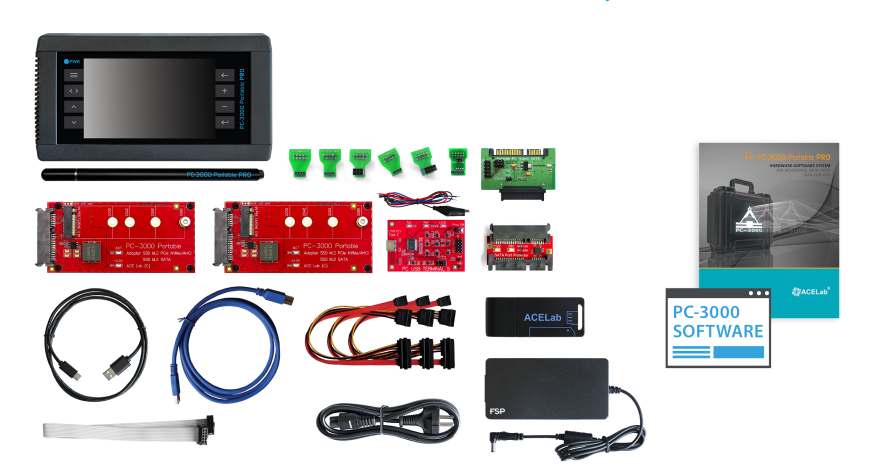
-
1 pc.
-
1 pc.
-
1 pc.
-
1 pc.
-
1 pc.
-
1 pc.
-
1 pc.
-
1 pc.
-
1 pc.
-
3 pcs.
-
1 pc.
-
1 pc.
-
1 pc.
-
PC-3000 Portable PRO manual (Available electronically)1 pc.
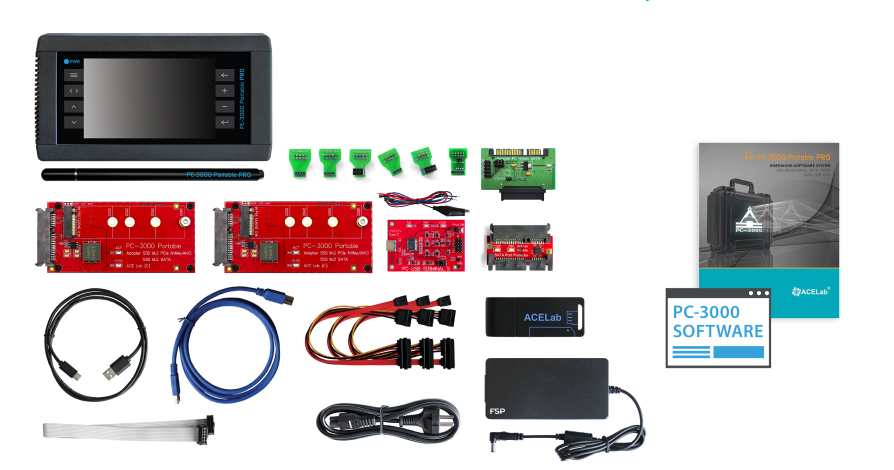
-
1 pc.
-
1 pc.
-
1 pc.
-
1 pc.
-
1 pc.
-
1 pc.
-
1 pc.
-
1 pc.
-
1 pc.
-
3 pcs.
-
1 pc.
-
1 pc.
-
1 pc.
-
PC-3000 Portable PRO manual (Available electronically)1 pc.
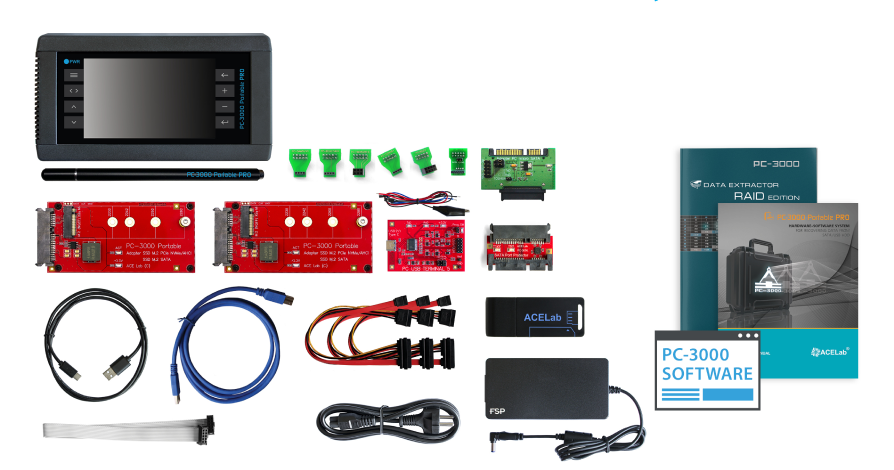
-
1 pc.
-
1 pc.
-
1 pc.
-
1 pc.
-
1 pc.
-
1 pc.
-
1 pc.
-
1 pc.
-
1 pc.
-
3 pcs.
-
1 pc.
-
1 pc.
-
1 pc.
-
PC-3000 Portable PRO manual (Available electronically)1 pc.
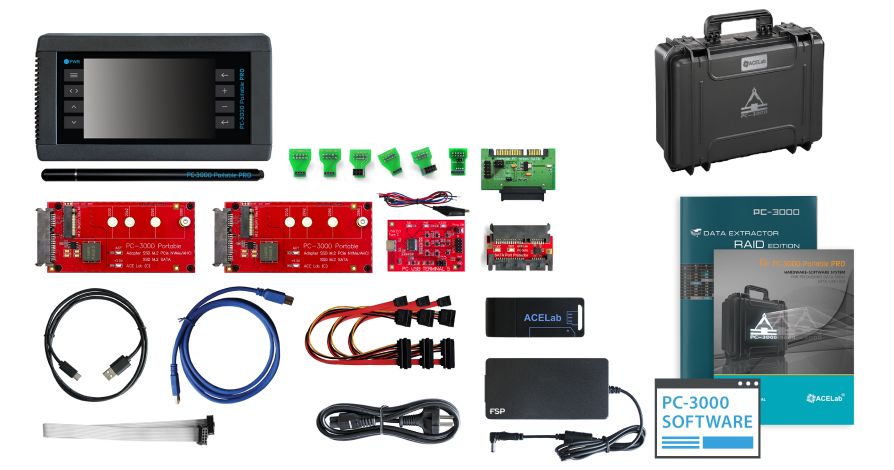
-
1 pc.
-
1 pc.
-
1 pc.
-
1 pc.
-
1 pc.
-
1 pc.
-
1 pc.
-
1 pc.
-
1 pc.
-
3 pcs.
-
1 pc.
-
1 pc.
-
1 pc.
-
1 pc.
-
PC-3000 Portable PRO manual (Available electronically)1 pc.

-
1 pc.
-
1 pc.
-
1 pc.
-
1 pc.
-
1 pc.
-
1 pc.
-
1 pc.
-
1 pc.
-
1 pc.
-
1 pc.
-
1 pc.
-
1 pc.
-
3 pcs.
-
1 pc.
-
1 pc.
-
1 pc.
-
1 pc.
-
PC-3000 Portable PRO manual (Available electronically)1 pc.
ADDITIONAL ADAPTERS FOR EXTENDED CAPABILITIES CAN BE PURCHASED OPTIONALLY
Damaged storage media is no longer a hindrance to your investigations!

Recover evidence when
all imagers and other
tools fail
4 diagnostic ports to recover data
Use 3 universal PCIe/SATA ports and 1 USB HOST port at the same time
More powerful 120W PSU is inside the delivery kit!


Breakthrough: now you can work with 3 pcie nvme at once!

Superb
for both on-site
and in-lab
data recovery

Make your own
workstation
out of one device
Hardware write protection to ensure evidence
integrity

Logging
and reports
generation
PC-3000 portable pro operating modes
Full-Featured Mode
of different complexity
as ever possible
Standalone mode for onsite recovery

Hash-sum calculations
when copying and reading data

Drive settings SMART view

Oscilloscope function

Sector view
What’s new in pro version?
| Comparative characteristics | PC-3000 Portable III | PC-3000 Portable PRO |
|---|---|---|
| ROM | 4 MB | 16 MB |
| RAM | 1 GB | 2 GB |
| Displayed diagonal screen area | 72 mm | 100 mm |
| Touch screen | no | yes |
| Graphical user interface | no | yes |
| Oscilloscope function | no | yes |
| Power Supply Unit | 90W | 120W |
| Main communication interface with the control computer | USB 3.0 | USB 3.1 |
| Number of simultaneously operating ports | 3 | 4 |
| Number of simultaneously operating NVMe/PCIe drives | 1 | 3 |
| Diagnostic Port 0 | PCIe/SATA 5V-3А, 12V-2,5А |
PCIe/SATA 5V-3А, 12V-2,5А |
| Diagnostic Port 1 | SATA 5V-2А, 12V-2,5А |
PCIe/SATA 5V-3А, 12V-2,5А |
| Diagnostic Port 2 | SATA 5V-2А, 12V-2,5А |
PCIe/SATA 5V-3А, 12V-2,5А |
| Diagnostic Port USB (HOST) | USB 3.0, 5V-2А | USB 3.1, 5V-3А |
| Support of Intel Optane SSD interface | no | yes |
| Improved anti-interference ability of PCB | no | yes |
| Ability to turn off and turn on the device from the touch screen button | no | yes |
Interface type: USB 3.1
Diagnostic ports: USB 3.1 (Host), Port 0 (PCIe / SATA), Port 1 (PCIe / SATA), Port 2 (PCIe / SATA)
Power adapter: 4-channel independent power adapter with protection from overvoltage and current overloading, with current and voltage measurements
Operating temperature range: 0-40°C thanks to the Climate Control System
Power Supply: 120W External AC / DC 19 V
Number of active licenses: 2 (to install the software on both a desktop computer and a laptop)
Other: Touch screen, non-volatile Memory to keep log files with date, time (GMT), username and settings which can be used in the reports later on.
The built-in lithium power supply ensures uninterrupted operation of the century-old calendar and world clock (UTC).

Recommended system requirements:
CPU: Intel Core i5 (4 cores, 4 threats) or AMD Ryzen 5;RAM: 16 GB;
Available disk space: 1TB HDD/SSD (for installation of software and HDD/SSD resources);
Operating system: Windows 10, 11*, x86, x64;
Display: Widescreen Full HD 1920x1080 display.
Ports: USB 3.1 Type-A port for connection of PC-3000 Portable PRO (an Intel xHCI HOST controller is recommended);
USB 3.1 Type-A or USB 2.0 port for PC-USB-TERMINAL connection.
* with switched off Secure Boot State in BIOS/UEFI and disabled Windows Core Isolation

Supported devices and file systems:
| SATA / PATA HDD (3.5", 2.5",1.8") |
Supported interfaces: |
SATA (Serial ATA) and USB devices compliant with the Mass Storage Device specification, i.e. external USB 2.0/3.0 HDD. SSHD (Solid State Hybrid Drive). PATA (PATA HDDs at least 250 GB) - via a special PC SATA-PATA adapter from ACE Lab which can be bought optionally. |
| Supported vendors: | Seagate, Western Digital, TOSHIBA, HITACHI / IBM (HGST), Samsung, Maxtor | |
| Supported capacities: | From 40 GB and more (without upper limit) | |
| SAS HDD / SSD (3.5", 2.5")* |
Supported interfaces: | SAS (Serial Attached SCSI) |
| Supported vendors: | Seagate, Western Digital, HITACHI / IBM (HGST), Fujitsu | |
| Supported capacities: | From 80 GB and more | |
| SSD** | Supported interfaces: |
SATA II/III Micro SATA, PATA, LIF, ZIF, Apple proprietary interface mSATA - via a special SATA-mSATA RAID adapter from ACE Lab which can be bought optionally M.2 SATA - via a special universal M.2 PCIe NVMe/AHCI SSD & M.2 SATA SSD adapter included in the delivery kit M.2 PCIe NVMe and M.2 (NGFF) - via a special universal M.2 PCIe NVMe/AHCI SSD & M.2 SATA SSD adapter included in the delivery kit The Apple MacBook SSD M.2 NGFF PCI-e NVMe Macbook SSD 2013-2019 (12+16 pin) - via the PCIe NVMe/AHCI Adapter for Apple Macbook SSD from ACE Lab which can be bought optionally PCIe NVMe x4 SSD installed into MacBookPro 13 laptops manufactured in 2016-2017 via a special MacBookPro A1706/A1708 adapter from ACE Lab which can be bought optionally PCIe x1-x16 - via the PCIe x16 SSD Adapter from ACE Lab which can be bought optionally CFexpress - via a special CFexpress Adapter from ACE Lab which can be bought optionally U.2/U.3 (SFF-8639) - via a special SSD PCIe U.2 Adapter from ACE Lab which can be bought optionally Intel Optane H10/H20 - via a special SSD PCIe NVMe/AHCI + Intel Optane Adapter from ACE Lab which can be bought optionally |
| Supported vendors: | A-DATA, AMD, Apacer, Corsair, Crucial, DEXP, Foxline, G.Skill, Gigabyte, GoodRam, HP, Intel, KingDian, Kingspec, Kingston, Kioxia, Lenovo, Lexar, Lite-On, Micron, OCZ, Patriot, Plextor, PNY, QUMO, RevuAhn, RunCore, Samsung, SanDisk, Seagate, Silicon Power, Smartbuy, TeamGroup, Toshiba, Transcend, WesternDigital etc. More manufacturers are added with the updates | |
| Supported capacities: | From 32 GB and more (without upper limit) | |
| USB Flash*** | Supported interfaces: |
USB devices that comply with the Mass Storage Device specification, i.e., external USB 2.0 / 3.0 Flash. SD/MicroSD Memory Cards via the special 2-in-1 Card Reader Adapter included in the delivery kit |
| Supported vendors: | A-DATA, Apacer, Corsair, Goodram, Kingston, Lexar, Samsung, Sandisk, Silicon Power, Smartbuy, Toshiba, Transcend, Verbatim and others | |
| Supported capacities: |
From 256 MB and more (without upper limit) Up to 1 TB for SD/MicroSD Memory Cards |
|
| RAID**** | Supported virtual RAID levels: |
|
| Files Systems | FAT, exFAT, NTFS, ReFS, HFS+, APFS, EXT2/3/4, XFS, F2FS, ReiserFS, BtrFS, VMFS, UFS1/2, ZFS, DHF4.1, WFS0.x (for video recorders) and virtual machine images | |
* for dealing with SAS HDD/SSD using your PC-3000 Portable PRO, you need to get the SAS adapter with Special Utilities additionally
** to work with Solid-State drives you need the PC-3000 solution which supports SSD: PC-3000 Portable SSD, Ultimate System or All-In-One System
*** the PC-3000 Portable PRO is able to recover data only from logically damaged (partition corruption, deleted files, damaged File System, etc.) Flash drives. To recover data from physically damaged Flash, you need PC-3000 Flash
**** to work with RAID you need the PC-3000 solution which supports RAID arrays: PC-3000 Portable RAID, Ultimate System or All-In-One System

| August 19, 2024 | The New Software Update: PC-3000 Ver. 7.5.x, Data Extractor Ver. 6.5.x, PC-3000 SSD Ver. 3.5.x has been released |
The new PC-3000 Express/UDMA/SAS/Portable software version 7.5.x has been released.
The latest update brings a lot of new useful features, like full support of 4K displays into the PC-3000 interface, new families for WD Marvell and Seagate F3, the new HDD ROM wizard for Seagate drives as well as the new implementation of T2 translator recovery with WDC Marvell utilities and the new Silicon Motion controllers. Check out the full article and watch our new overview video! |
|
| Read more... |
|
| February 09, 2024 | Supermassive Software Update: PC-3000 Ver. 7.4.x, Data Extractor Ver. 6.4.x, PC-3000 SSD Ver. 3.4.x |
It’s one of the biggest PC-3000 updates ever, and it brings so many changes and improvements. See the list of the main enhancements in the full article ACE Lab technical engineers have made a short overview video of the new features available in the latest update. We highly recommend you to watch it from beginning to end for better understanding how the new modes and features work. |
|
| Read more... |
|
| June 8, 2023 | New PC-3000 Ver. 7.3.6, Data Extractor Ver. 6.3.6 / PC-3000 SSD Ver. 3.3.3 has been released |
|
The latest PC-3000 Software is available! All this is available in the freshly-released versions of the English, Chinese, Japanese, and Korean software:
All authorized technical support users will get the latest software version. |
|
| Read more... |
|
| December 8, 2022 | The new PC-3000 Software Ver. 7.2.12, Data Extractor / Data Extractor RAID Edition Ver. 6.2.11, PC-3000 SSD Ver. 3.2.9 has been released |
|
The latest PC-3000 Software is available! Thanks to the new SDK we have recently switched to, it's already been the 3rd major software update released this year. The new update has brought the enhanced T2 Reading and Analysis Mode, the support of PS5012, PS3112, and of new SAS SSDs, as well as many more other useful features to improve your work with data recovery cases! All this is available in the freshly-released versions of the English, Chinese, Japanese, and Korean software:
All authorized technical support users will get the latest software versions. |
|
| Read more... |
|
| June 2, 2022 | A new software version of the PC-3000 Ver. 7.1.6, Data Extractor / Data Extractor RAID Edition Ver. 6.1.6, PC-3000 SSD Ver. 3.0.4 has been released |
|
Great news for the data recovery community: with the new PC-3000 Software Update, you can unlock the Techno Mode for WD SED drives of all SMR 2.5" and 3.5” families without any custom PCB. It’s the easiest and most convenient way how to do this! This release has also brought the support of LVM2 thin pools and PS5016 PCIe 4.0 NVME drives as well as loaders for PS3111 and SM2259XT controllers. These features and many more are already available in the latest version of the English, Chinese, Japanese, and Korean software:
All authorized technical support users will get the latest software versions. |
|
|
Read
more... |
|
| February 16, 2022 | The New PC-3000 Software Version is Available! |
|
At the ACE Lab Webinar on the Modern Challenges in Data Recovery & Digital Forensics, our technical engineers showed the features available with the PC-3000 Version 7.0.x., for example, TLER (time-limited error recovery) for WD HDD, the Data Extractor error-processing scenario, and the support of new NVMe drives based on Marvell 88SS1093 controller. These features and more are now available in the latest version of the PC-3000 Software:
|
|
|
Read
more... |
|
| May 26, 2021 | A new software version of the PC-3000 Ver. 6.9.9, Data Extractor / Data Extractor RAID Edition Ver. 5.12.5, PC-3000 SSD Ver. 2.10.2 has been released |
|
Since now, it's possible to work with Phison PS3111-based drives, which have YMTC NAND memory on board. The new update brings an opportunity to decrypt the external USB drive Transcend ESD230C with SM2258XT controller, and also it brings extended loaders support for SM2259XT drives, improvements in software stability and speed. Hurry up to download the latest version of the English, Chinese, Japanese and Korean software:
All authorized technical support users will get the latest software versions. |
|
|
Read
more... |
|
| April 30, 2021 | The Most Recent Software Versions of the PC-3000 Portable/Express/UDMA/SAS, Data Extractor/Data Extractor RAID Edition, PC-3000 SSD/PC-3000 SSD Extended are Released! |
|
The ACE Lab Online TechCon on Data Recovery & Digital Forensics 2021 revealed a huge number of the most up-to-date features for your PC-3000 tools: support of the new drives families and controllers, T2 Recovery visual mode for SMR drives, a new class of additional maps, and many others functions that make your data recovery job easier and faster. Hurry up to download the latest version of the English, Chinese, Japanese and Korean software:
All authorized technical support users will get the latest software versions. |
|
|
Read
more... |
|
| December 10, 2020 | The new versions of PC-3000 Portable/Express/UDMA Ver. 6.8.8, Data Extractor / Data Extractor RAID Edition Ver. 5.11.5, PC-3000 SSD / PC-3000 SSD Extended Ver. 2.9.5 are available! |
|
We continually enhance the PC-3000 tools by adding new modes, algorithms, and functions. Today we are glad to announce that the following English, Japanese, Korean, and Chinese software updates are released:
All authorized technical support users will get the latest software versions. |
|
|
Read
more... |
|
| October 16, 2020 | The PC-3000 Portable III Now Supports the Silicon Motion SM2258XT SSDs! |
|
ACE lab developers have done a great job by researching Silicon Motion SM2258XT SSDs and optimizing the algorithms to make the most efficient and stable Utility for this type of the drives. As such, you can now raise your data recovery success rate by dealing with Silicon Power Slim S55, KingDian S200, WD Green, Apacer AS350 Panther, Patriot P200, Smartbuy Jolt, RevuAhn 885, Crucial BX500, and other SM2258XT SSDs. The support appears with the beta version of the PC-3000 SSD Extended software ver. 2.9.3 available for the PC-3000 Portable III users. To get the beta version of the software, please contact our Technical Support Department. |
|
|
Read
more... |
|
| September 30, 2020 | The New Software Add-On: PC-3000 SSD Extended! |
|
The ACE Lab developers constantly research drives which results in a rapid expansion of the support list for the most modern storage media devices. Today, we have released PC-3000 SSD Extended – the new software add-on that supports the widest range of SSD types: SATA, mSATA, M.2 SATA, M.2 PCIe NVMe/АHCI, PCIe x16, Apple Macbook, LIF, ZIF, PATA. The additional features of the PC-3000 SSD Extended add-on for PCIe SSD (NVMe/AHCI) appear with the beta version of software available for the PC-3000 Portable III users only. To get the beta version of the software, please contact our Technical Support Department. |
|
|
Read
more... |
|
| April 30, 2020 | The new versions of PC-3000 Express/UDMA-E/Portable Ver. 6.7.12, Data Extractor Ver. 5.10.7, Data Extractor RAID Edition Ver. 5.10.7, PC-3000 SSD Ver. 2.8.2 are available! |
|
Last week, you saw a lot of new PC-3000 functions at the ACE Lab Online Technology Conference on Data Recovery & Digital Forensics 2020. Today all these features are waiting for you in your update boxes! The following English, Chinese, Japanese and Korean software updates are released:
All authorized technical support users will get the latest software versions. More details are available in the link below. |
|
|
Read
more... |
|
| April 14, 2020 | The PC-3000 Portable III Now Supports the NVMe SSDs Based on Phison PS5007 Controller! |
|
The PC-3000 Portable III is the first and the only solution for recovering data from PCIe NVMe SSDs using the Techno Mode. At the initial release, it supported only Silicon Motion SSDs based on SM2260 and SM2263 controllers. But it was just the beginning! Now we have significantly expanded the list of supported drives by adding the NVMe SSDs based on the Phison PS5007 controller. And since all the PS5007-based SSDs are technically the same, you can recover data from any model based on this controller, even if it’s not listed in the Utility. More details are available in the link below. |
|
|
Read
more... |
|
| March 23, 2020 | The PC-3000 Portable III Is Even Faster and More Powerful Now! |
|
ACE Lab developers continue enhancing the software of the PC-3000 Portable III System with new features for the user community. As a result, the most universal and powerful tool became even faster – now the speed of internal copying is up to 490 MB/s. We also added the support of HDDs and SSDs with a logical sector size other than 512 bytes that had not previously been possible. Besides, it’s no longer required to disable the Secure Boot option in UEFI (BIOS) before the PC-3000 Portable III installation. More details are available in the link below. |
|
|
Read
more... |
|
| March 10, 2020 | The PC-3000 Portable III: New Features and Supported Devices |
|
The well-designed and flexible architecture of the PC-3000 Portable III allows the ACE Lab developers to continue enhancing this incredibly powerful product on the software and internal firmware levels. As such, you get a hardware-software tool that is constantly evolving by obtaining a lot of new features and supporting new models of storage media devices, along with new standards and interfaces. There are so many features that have been added to the PC-3000 Portable III just within one month! Take a glance at them by clicking the link below. |
|
|
Read
more... |
|
| January 20, 2020 | The new version of the PC-3000 software ver. 6.7.x and Data Extractor/Data Extractor RAID Edition ver.5.10.x for the PC-3000 Portable III Systems |
|
The PC-3000 Portable III Systems come with a new version of the PC-3000 software ver. 6.7.x and Data Extractor/Data Extractor RAID Edition ver.5.10.x. More details are below: WD Marvell
Seagate F3
Seagate ST10
HITACHI-IBM-ARM
Samsung HDD
Toshiba
The PC-3000 Core
RAW recovery
Silicon Motion
Phison
|
|
|
Read
more... |
|
M.2 PCIe NVMe/AHCI SSD & M.2 SATA SSD adapter

SAS adapter with special software utilities

PC-SATA-PATA adapter set

SSD PCIe NVMe/AHCI + Intel Optane Adapter

SSD PCIe U.2 Adapter

PCI-E x16 SSD Adapter

PCIe NVMe/AHCI Adapter for Apple Macbook SSD

MacBookPro A1706/A1708 adapter

SATA-mSATA RAID adapter

2-in-1 SD/microSD Card Reader adapter

SATA Port Protector adapter


-
1 pc.
-
1 pc.
-
1 pc.
-
1 pc.
-
1 pc.
-
1 pc.
-
1 pc.
-
1 pc.
-
1 pc.
-
3 pcs.
-
1 pc.
-
1 pc.
-
1 pc.
-
PC-3000 Portable PRO manual (Available electronically)1 pc.

-
1 pc.
-
1 pc.
-
1 pc.
-
1 pc.
-
1 pc.
-
1 pc.
-
1 pc.
-
1 pc.
-
1 pc.
-
3 pcs.
-
1 pc.
-
1 pc.
-
1 pc.
-
PC-3000 Portable PRO manual (Available electronically)1 pc.

-
1 pc.
-
1 pc.
-
1 pc.
-
1 pc.
-
1 pc.
-
1 pc.
-
1 pc.
-
1 pc.
-
1 pc.
-
3 pcs.
-
1 pc.
-
1 pc.
-
1 pc.
-
PC-3000 Portable PRO manual (Available electronically)1 pc.

-
1 pc.
-
1 pc.
-
1 pc.
-
1 pc.
-
1 pc.
-
1 pc.
-
1 pc.
-
1 pc.
-
1 pc.
-
3 pcs.
-
1 pc.
-
1 pc.
-
1 pc.
-
1 pc.
-
PC-3000 Portable PRO manual (Available electronically)1 pc.

-
1 pc.
-
1 pc.
-
1 pc.
-
1 pc.
-
1 pc.
-
1 pc.
-
1 pc.
-
1 pc.
-
1 pc.
-
1 pc.
-
1 pc.
-
1 pc.
-
3 pcs.
-
1 pc.
-
1 pc.
-
1 pc.
-
1 pc.
-
PC-3000 Portable PRO manual (Available electronically)1 pc.


